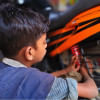Millions at risk of child labour in manufacturing hubs: Study

Child labour is an "extreme risk" in one in 10 countries globally, found an index today, urging businesses to be more vigilant about abuses in their global supply chains.
Little progress was recorded in key manufacturing hubs India and China, which ranked 47th and 98th out of 198 countries in the Child Labour Index, with North Korea in first place with the highest risk, said research consultancy Verisk Maplecroft.
The 10 worst performing countries in 2019 are:
1. North Korea (ranked 1st and highest risk globally)
2. Somalia
3. South Sudan
4. Eritrea
5. Central African Republic
6. Sudan
7. Venezuela
8. Papua New Guinea
9. Chad
10. Mozambique
India and China had a high level of reported incidents and had made "no tangible improvement" on reducing child labour risks since 2016, when Verisk Maplecroft started collecting directly comparable data.
There was also little headway in other countries whose industries are enmeshed in global supply chains, including Ethiopia, Bangladesh, Turkey and Vietnam, the index showed.
"The economic momentum of many countries is yet to trickle down to the poorest in society," said Oscar Larsson, a human rights data analyst at the UK-based company.
"Child labour is still prevalent across many sectors and if countries aren't taking action it is up to companies to see they have the tools to ensure it's not happening under their watch."
There are about 150 million child labourers around the world, according to the International Labour Organization (ILO), the majority working on farms in Africa and Asia.
The ILO has said the world is unlikely to meet a target of ending child labour by 2025, which is part of 17 global development goals agreed in 2015 at the United Nations.
The Child Labour Index aims to help businesses identify and root out child labour in their often complex international supply chains, where a lack of direct oversight and many layers of subcontracting can conceal workplace abuses.
The scores were calculated by assessing laws against child labour, the extent to which regulations are enforced, and the frequency and severity of known child labour incidents.
A total of 27 countries -- which account for more than 10% of the world's population -- were found to have an "extreme risk" of child labour, with Somalia, South Sudan, Eritrea and the Central African Republic completing the top five on the index.
"The risks on child labour are still very high and too little progress is being made on tackling the issue," Jos de Voogd from international children's rights group Terre des Hommes told the Thomson Reuters Foundation.
"Businesses are reluctant to screen their whole supply chain, with the excuse that it is too complicated, which means no one feels responsible for the lowest tiers... Companies need to be encouraged to take action."

 For all latest news, follow The Daily Star's Google News channel.
For all latest news, follow The Daily Star's Google News channel. 








Comments